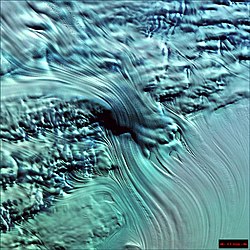Lambert Glacier

Lambert Glacier is a major glacier in East Antarctica. At about 50 miles (85 km) wide, over 250 miles (400 km) long, and about 2,500 m deep, it holds the Guinness world record for the world's largest glacier. It drains 8% of the Antarctic ice sheet to the east and south of the Prince Charles Mountains and flows northward to the Amery Ice Shelf.[1] It flows in part of Lambert Graben and exits the continent at Prydz Bay.
This glacier was delineated and named in 1952 by American geographer John H. Roscoe who made a detailed study of this area from aerial photographs taken by Operation Highjump, 1946–47. He gave the name "Baker Three Glacier", using the code name of the Navy photographic aircraft and crew that made three flights in this coastal area in March 1947 resulting in geographic discoveries. The glacier was described in Gazetteer No. 14, Geographic Names of Antarctica (U.S. Board on Geographic Names, 1956), but the feature did not immediately appear on published maps. As a result the name Lambert Glacier, as applied by the Antarctic Names Committee of Australia in 1957 following mapping of the area by Australian National Antarctic Research Expeditions in 1956, has become established for this feature. It was named for Bruce P. Lambert, Director of National Mapping in the Australian Department of National Development.[2]
Remote sensing

The glacier is important in the study of climate change because very small changes in the climate can have significant consequences for the flow of ice down the glacier.[3] Most studies of the Lambert Glacier are done with remote sensing due to the harsh conditions in the area.[4]
The photo reproduced here (above) shows a small tributary right-flank glacier flowing down from the ice-covered East Antarctic Plateau, flanked by slower-moving ice flowing down over a steep escarpment. The ice-fall which so impressively illustrates the flow characteristics of glacier ice is only about 6 km wide, and Lambert Glacier proper is off the bottom right corner of the photo. The ice here is flowing at about 500 m per year, but velocities of over 1200 m per year are known at the edge of the Amery Ice Shelf, which is fed by this gigantic stream of ice.
On the lower photo north is at the bottom, and the ice velocities are approximately as follow:
- Brown areas—up to 50 m per year.
- Green areas—up to 250 m per year.
- Blue areas—up to 500 m per year.
- Purple areas—around 1000 m per year.
- Red area—up to 1200 m per year.
See also
References
- ^ Tulloch, Coral (2003). Antarctica: Heart of the World. Sydney: ABC Books. p. 11. ISBN 0-7333-0912-7.
{{cite book}}: Cite has empty unknown parameter:|coauthors=(help) - ^ "Lambert Glacier". Geographic Names Information System. United States Geological Survey, United States Department of the Interior. Retrieved 2013-05-24.
- ^ Scott, Keith (1993). The Australian Geographic book of Antarctica. Terrey Hills, New South Wales: Australian Geographic. p. 127. ISBN 1-86276-010-1.
- ^ "Antarctic Glacier May Yield Clues To Global Climate Change". ScienceDaily. 2002-06-26. Retrieved 2009-08-12.
![]() This article incorporates public domain material from "Lambert Glacier". Geographic Names Information System. United States Geological Survey.
This article incorporates public domain material from "Lambert Glacier". Geographic Names Information System. United States Geological Survey.
